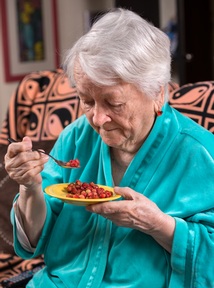Ten top tips to help care homes provide nutritious and hygienic food
It is vital that older people in care homes have a good, nutritious diet as this can be instrumental in protecting them against a whole range of age-related conditions, such as cardiovascular disease, dementia, bowel problems and osteoporosis.

As well as a balanced diet, the British Nutrition Foundation recommends that older people eat two portions of fish a week, one of which should be oily. Oily fish contains long chain omega-3 fatty acids which can help protect against heart disease and reduce some of the symptoms of rheumatoid arthritis.
People who are older find it harder to absorb Vitamin D through sunlight through the skin, so it is important their diet is supplemented with foods rich in Vitamin D such as eggs, oily fish and fortified cereals. The Department of Health advises that people aged 65 and over should take a daily 10 microgram vitamin D supplement.
Malnutrition can be a problem for the older generation, as senses such as taste and smell deteriorate affecting people’s enjoyment of food and leading them to eat smaller amounts. Despite this loss of appetite, older people still need essential nutrients and these can be given through smaller meals complemented with healthy snacks.
Conversely obesity is also a problem due to limited mobility as people age causing them to exercise less and put on weight which can lead to Type 2 diabetes.
Hygiene when preparing food is also critical, with a spokesman for the Nationwide Caterers Association (NCASS), saying: “When you work in a care home you work with some of the most vulnerable people in our society. Sadly with old age and weakening immune systems, residents are particularly susceptible to contracting food-related illnesses.
“That’s why it’s absolutely crucial that all staff who handle food within your care home know exactly what they are doing when it comes to preparing food for residents.”
NCASS has ten top tips for care homes to keep residents as healthy as possible
1. Create a menu which promotes a balanced diet
It’s important for the elderly to consume a nutrient-rich diet so that they can get access to proteins, vitamins, minerals, meat, eggs, fish, bread, cereals and fruit and veg. Make sure your menu reflects their dietary requirements (but tastes good too!).
2. Offer healthy snacks for those who are unable to cope with large meals
Some old people find it difficult to manage larger meals in one sitting. It’s important that you offer healthy snacks or smaller options to these people to ensure they still receive the right nutrients.
3. Complete appropriate levels of accredited hygiene training
The Health and Social Care Act 2008 states that anyone employed by a care service provider must receive appropriate training and be able to prove that they always meet professional standards. An easy way to cover those requirements is to make sure all food-handling staff have undergone triple-accredited food hygiene training (to at least level 2). And you can do that with NCASStraining.co.uk.
4. Wash your hands correctly and regularly
The law is really clear on hand washing matters. All staff need to wash their hands regularly and in the correct way, using a sink that’s different from the one where food and equipment is washed. Alcohol gels are not an option. Make sure that every food handler knows exactly how to wash their hands (you can find tips on the NCASS YouTube channel).
5. Keep raw and ready-to-eat foods separate
Stopping cross-contamination doesn’t have to be a hard task. Use separate chopping boards, plates, utensils and storage areas for your raw and ready-to-eat foods to stop dangerous bacteria from spreading.
6. Be extremely vigilant in monitoring use-by dates
You should never use food that’s passed its use-by date, even if it looks or smells like you could. Doing so could put the health of your care residents at risk. Make sure you strictly follow storage instructions too, or the food could go off more quickly, creating a higher risk of food poisoning.
7. Keep fresh foods out of the fridge for the shortest periods possible
Keeping high risk foods refrigerated is really important to help slow down the growth of germs and bacteria. Remove fresh foods from the fridge as late as possible in the cooking process, to reduce the amount of time it is kept unrefrigerated.
8. Stick to a tight cleaning schedule
Create and maintain a cleaning schedule to help you make sure that all areas and equipment are cleaned regularly and to reduce the risk of cross-contamination in your kitchen space. Make sure all staff stick to the schedule and that they adopt a ‘clean-as-you-go’ policy too.
9. Make sure your cleaning products are up to the task
It’s crucial that you use the correct cleaning products for each task in hand. Make sure that staff know when to use detergents, disinfectants and sanitisers; they each have their own specific role after all.
10. Say goodbye to dishcloths
Dirty cloths are a major cause of cross contamination. Avoid using dish cloths or wiping cloths unless they are disposable or washed regularly in a high temperature wash. If in doubt, stick to disposable paper roll for all cleaning and drying.
Make sure that all food-handling staff follow these handy tips to reduce the risk of your residents falling ill with food poisoning. For more information about hygiene training for care home employees, please visit www.ncasstraining.co.uk/carehomes.
Latest Innovative Care News
 13-May-19
'Pink drink' brain cancer treatment rolled out across NHS in memory of Baroness Jowell
13-May-19
'Pink drink' brain cancer treatment rolled out across NHS in memory of Baroness Jowell
 25-Apr-19
Louis Tomlinson helps 83-year-old who lost wife to dementia complete bucket list
25-Apr-19
Louis Tomlinson helps 83-year-old who lost wife to dementia complete bucket list
 22-Mar-19
UK's top care home handyman takes residents to pub for pie and pint
22-Mar-19
UK's top care home handyman takes residents to pub for pie and pint
 12-Feb-19
Michael McIntyre's jokes tested to see if they stop elderly catching flu
12-Feb-19
Michael McIntyre's jokes tested to see if they stop elderly catching flu
 07-Jan-19
'We were lucky to find it': Family's delight as care home is rated Outstanding
07-Jan-19
'We were lucky to find it': Family's delight as care home is rated Outstanding